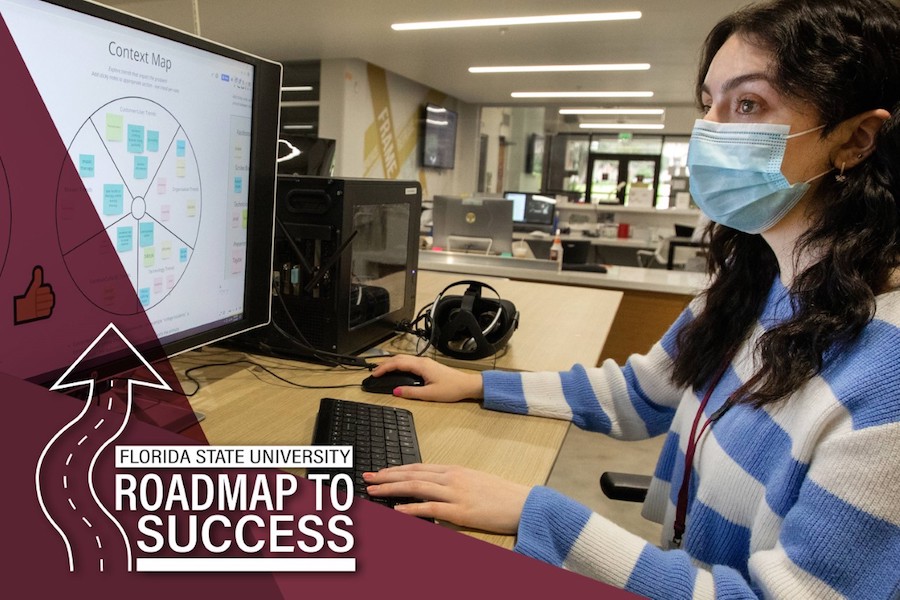
When Florida State University mapped out strategic goals in 2017 that would guide its path in strengthening the university, deepening its commitment to innovation and entrepreneurship was at the top of the list.
FSU’s efforts to pursue that goal have included creating the first standalone college of entrepreneurship in the nation with the Jim Moran College of Entrepreneurship, as well as an across-the-board push to kindle an intrepid spirit in students. Since 2017, the university has increased its entrepreneurship and innovation course offerings 143 percent, raising undergraduate enrollment in these classes by 73 percent.
The team at the FSU Innovation Hub is helping to lead the way through teaching students a process known as Design Thinking. The concept taps into students’ creativity and makes them marketable in an evolving and competitive labor market.
“A very small percentage of students are going to be entrepreneurs; the vast majority are going to work for big companies,” said Ken Baldauf director of the Innovation Hub. “Part of their challenge is going to be how to get your ideas recognized within large corporations. They need people with unique ideas, who know how to work in teams to develop solutions. That’s the skillset that is appreciated by the companies and corporations that employ our undergraduates.”
At its heart, Design Thinking is about tapping people from diverse, multidisciplinary backgrounds and harnessing that diversity of thought to develop innovative solutions to address pressing problems.
For students who come to the Innovation Hub for its many innovation, entrepreneurship and technology courses, Baldauf said Design Thinking gives them a framework for how to accomplish their objectives and position them for success in their careers.
Design Thinking gives students those tools and helps them bring their unique experiences and skills to bear, Baldauf said.
Design Thinking’s approach to creative problem solving includes three sequential steps. Those three steps can go by different labels but at FSU, they are: empathy, ideate and build.
When implemented, that means practitioners of design thinking first seek to understand a problem deeply and from the perspective of those experiencing its consequences. From that position of empathy, they then harness the brainpower of a multidisciplinary group with the aim of embracing unique perspectives designed to avoid assumptions and barriers.
From here, the team then develops prototype solutions that are tested and refined until the best solution is revealed. The team works directly with stakeholders through the process, using their feedback to help guide the work.
“(Companies) need people with unique ideas, who know how to work in teams to develop solutions. That’s the skillset that is appreciated by the companies and corporations that employ our undergraduates.”
— Ken Baldauf, director of FSU’s Innovation Hub
While the process is embraced in projects undertaken throughout the Innovation Hub, Baldauf also teaches a class “Innovation By Design” in the Jim Moran College of Entrepreneurship, which is open to all students. In the class, students identify challenges they’d like to tackle, topics like homelessness, student debt and financial literacy are among those selected. Students are then put into groups and use Design Thinking principles to develop a solution.
Through partnerships like those between FSU and IBM, Accenture and other large consulting firms, Baldauf said students are seeing firsthand the practical benefits of Design Thinking.
“IBM doesn’t care much what your major is now,” he said. “They are looking for people who have an imagination, who work well with others and who are motivated.”
Mike Meth also teaches sections of “Innovation By Design” at FSU. Meth, who is associate dean of research and learning services at FSU Libraries, said he sees every semester how students benefit from their introduction to the process.
“One of the great strengths of Design Thinking is that it encourages the seeking of other perspectives and really draws you out from your own biases and preconceived notions,” he said. “The Design Thinking process encourages collaboration and gains strength from incorporating as many different voices as possible.”
Meth said the benefits of the process are ones that students carry with them from the classroom, to their jobs and ultimately, into their personal relationships.
“At its center is empathy,” he said. “We hear from students every semester that they love their teammates, and these are students we put together to work on some very serious real-life problems who have never collaborated before. The process fosters personal and team growth and leads them to a point where meaningful relationships form. It’s a powerful mechanism that really invites new perspectives in and encourages them. That’s why I am so sold on Design Thinking.”
For her part, Zoe Harris, a senior marketing major from Winter Park, Florida, agreed. Harris is currently taking “Innovation By Design” with Baldauf and said the course has exceeded her expectations.
“It forces you out of your comfort zone,” she said. “It’s not just listening, it’s doing, putting things into practice. It’s very hands on so it helps your collaboration skills, your critical thinking and your empathy.”
Harris said the skills she’s building through Design Thinking are ones she’ll use long after she graduates this spring.
“I’ll be taking these skills with me into the future,” she said. “It looks good on a resume to say you’re practicing Design Thinking, but more importantly, it’s really, really fun. It’s my favorite class I’ve taken at FSU, and it’s my last semester here. I’d recommend it to anyone.”



